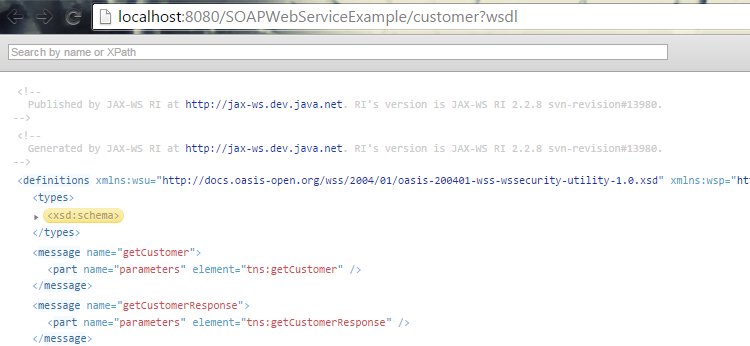Web service application with JAX-WS and Spring
1. Introduction
It has been a long wait, but I am finally publishing a tutorial on creating the first SOAP based web service application with Spring. JAX-WS (Java API for XML Web Services) is a set of APIs for creating web services in XML format, which we also most commonly call as SOAP based web service, which hope we all are aware of the basic architecture.
2. Implementation
To start with, let’s check out the pom file configuration –
pom.xml
<!-- Spring dependencies --> <dependency> <groupId>org.springframework</groupId> <artifactId>spring-core</artifactId> <version>4.2.1.RELEASE</version> </dependency> <dependency> <groupId>org.springframework</groupId> <artifactId>spring-web</artifactId> <version>4.2.1.RELEASE</version> </dependency> <!-- JAX-WS --> <dependency> <groupId>org.jvnet.jax-ws-commons.spring</groupId> <artifactId>jaxws-spring</artifactId> <version>1.9</version> </dependency> <dependency> <groupId>com.sun.xml.ws</groupId> <artifactId>jaxws-rt</artifactId> <version>2.2.8</version> </dependency>
web.xml
<?xml version="1.0" encoding="ISO-8859-1"?>
<web-app xmlns:xsi="http://www.w3.org/2001/XMLSchema-instance"
xmlns="http://java.sun.com/xml/ns/javaee"
xsi:schemaLocation="http://java.sun.com/xml/ns/javaee
http://java.sun.com/xml/ns/javaee/web-app_2_5.xsd"
id="WebApp_ID" version="2.5">
<display-name>SOAPWebServiceExample</display-name>
<listener>
<listener-class>org.springframework.web.context.ContextLoaderListener</listener-class>
</listener>
<servlet>
<servlet-name>customer</servlet-name>
<servlet-class>com.sun.xml.ws.transport.http.servlet.WSSpringServlet</servlet-class>
<load-on-startup>1</load-on-startup>
</servlet>
<servlet-mapping>
<servlet-name>customer</servlet-name>
<url-pattern>/customer</url-pattern>
</servlet-mapping>
</web-app>Let’s create the Customer entity for our application.
Customer.java
package com.jcombat.entity;
public class Customer {
private int id;
private String name;
public int getId() {
return id;
}
public void setId(int id) {
this.id = id;
}
public String getName() {
return name;
}
public void setName(String name) {
this.name = name;
}
}Let’s now create the service interface and its corresponding service implementation class.
CustomerService.java
package com.jcombat.services.customers;
import com.jcombat.entity.Customer;
public interface CustomerService {
public Customer getCustomerById(String customerId);
}CustomerServiceImpl.java
package com.jcombat.services.customers;
import com.jcombat.entity.Customer;
public class CustomerServiceImpl implements CustomerService {
public Customer getCustomerById(String customerId) {
Customer customer = new Customer();
customer.setId(123);
customer.setName("Abhimanyu");
return customer;
}
}Below is how the applicationContext should look like.
applicationContext.xml
<?xml version="1.0" encoding="UTF-8"?>
<beans xmlns="http://www.springframework.org/schema/beans"
xmlns:xsi="http://www.w3.org/2001/XMLSchema-instance" xmlns:ws="http://jax-ws.dev.java.net/spring/core"
xmlns:wss="http://jax-ws.dev.java.net/spring/servlet"
xsi:schemaLocation="http://www.springframework.org/schema/beans
http://www.springframework.org/schema/beans/spring-beans-2.5.xsd
http://jax-ws.dev.java.net/spring/core
http://jax-ws.java.net/spring/core.xsd
http://jax-ws.dev.java.net/spring/servlet
http://jax-ws.java.net/spring/servlet.xsd">
<bean id="customerService" class="com.jcombat.services.customers.CustomerServiceImpl">
</bean>
<bean id="customerEndpoint" class="com.jcombat.ws.CustomerEndpoint">
<property name="service" ref="customerService" />
</bean>
<wss:binding url="/customer">
<wss:service>
<ws:service bean="#customerEndpoint" />
</wss:service>
</wss:binding>
</beans>Note that a URL pattern (/customer) is bound to the web service endpoint implementation class (customerEndpoint), as can be seen in the above snippet. Below is how our customerEndpoint bean implementation class looks like.
CustomerEndpoint.java
package com.jcombat.ws;
import javax.jws.WebMethod;
import javax.jws.WebService;
import com.jcombat.entity.Customer;
import com.jcombat.services.customers.CustomerService;
@WebService(serviceName = "customerService")
public class CustomerEndpoint {
private CustomerService service;
@WebMethod(exclude = true)
public void setService(CustomerService service) {
this.service = service;
}
@WebMethod(operationName = "getCustomer")
public Customer getCustomerById(String customerId) {
Customer customer = service.getCustomerById(customerId);
return customer;
}
}Note that @WebService annotation tells the server runtime environment to expose all the public methods of that class as web service methods. If we want to prevent any of the methods to be exposed as web service method, we need to annotation the method with @WebMethod(exclude = true), as can be seen in the above snippet. Similarly if we want to name the web service method to something different from the actual method name specified in the class (getCustomerById()), we need to add an operationName attribute to the @WebMethod annotation.
- If you face any dependency issues while setting up the project, you can refer this link.
3. Running the application
- http://localhost:8080/SOAPWebServiceExample/customer?wsdl
Once we hit the above URL, we can see the WSDL content displayed, as can be seen in the below snapshot.
We can also test the endpoint with SOAP UI as well. Create the new SOAP project with the same WSDL location as mentioned above.
4. Download the source code
| Reference: | Web service application with JAX-WS and Spring from our JCG partner Abhimanyu Prasad at the jCombat blog. |







